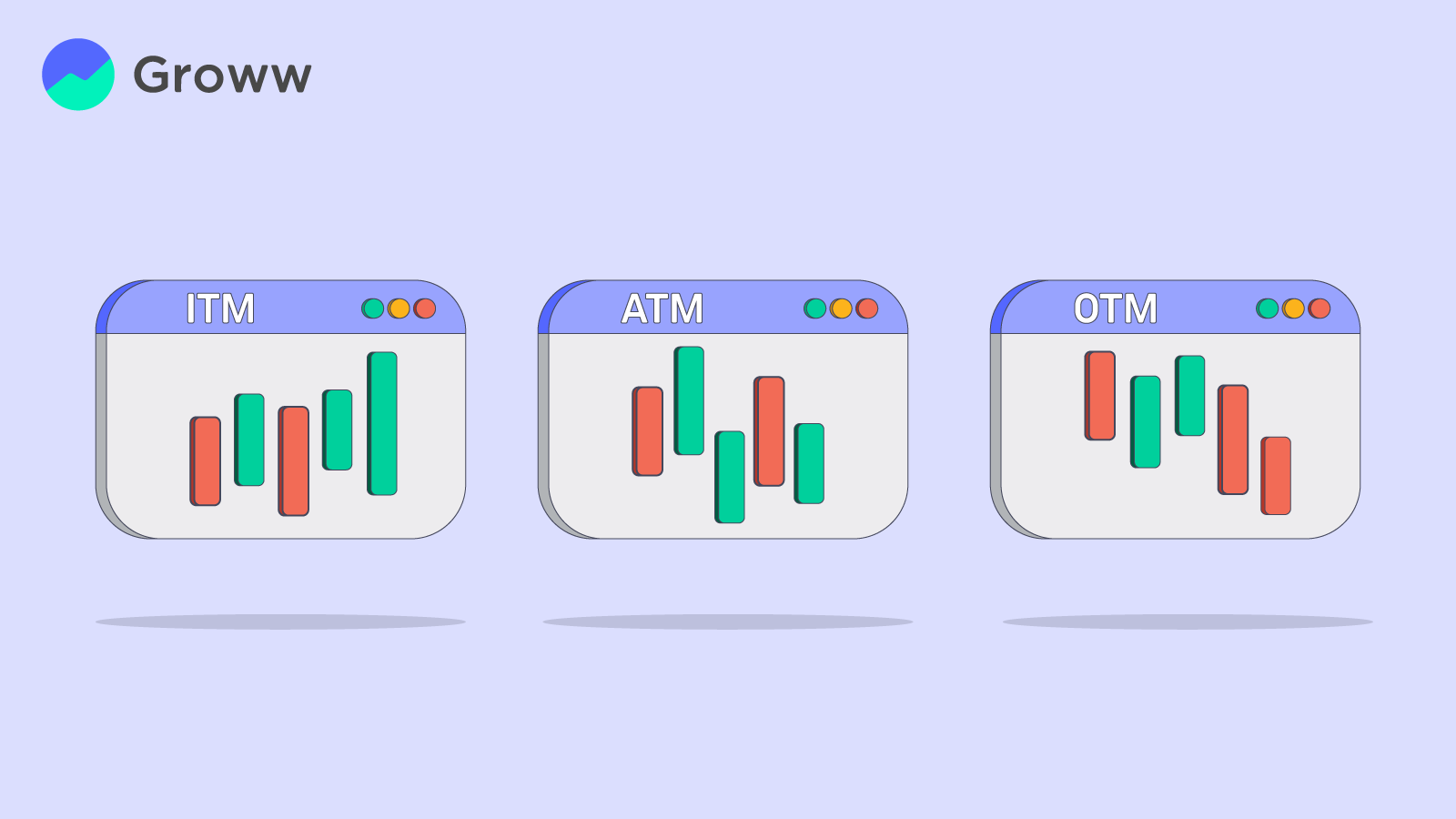Difference Between ITM, OTM, ATM in Call and Put Options

Understanding the differences between In-The-Money (ITM), Out-of-The-Money (OTM) and At-The-Money (ATM) options is crucial for anyone trading in the options market. An intrinsic value dictates the categorisation of options contracts into these three types. It is basically the difference between the strike price of an options contract and the spot price of an asset.
This value helps to determine whether an option is ITM, ATM or OTM. Keep reading to understand the differences between the three.
Call Options
When you buy a call option, you are granted an opportunity to purchase stocks or shares at the strike price if it is beneficial.
Let us explore what ITM, OTM and ATM mean for a call option.
-
In-The-Money (ITM) Call Option
When a call option's strike price is lower than an underlying asset's spot price, it is called an in-the-money call option. Suppose you are looking at Nifty options for May 2024 where the strike price is ₹11,800 and the spot price is ₹12,000.
Here your intrinsic value will be ₹200, which is an in-the-money call option. This type of option includes both time value and intrinsic value.
-
At-The-Money (ATM) Call Option
An at-the-money call option occurs when the strike price of the option is nearly equal to the spot price of an underlying asset.
If both strike price and spot price are around ₹12,000, the option would be considered at-the-money, like the NIFTY JAN 12,000 CALL. These options lack intrinsic value and only have time value.
-
Out-of-The-Money (OTM) Call Option
When the strike price of a call option is higher than the spot price of an underlying asset, it is an out-of-the-money call option.
For example, if the strike price is ₹12,200 and the spot price is ₹12,000 in the Nifty options, such as NIFTY MAY 12,200 CALL, it is an OTM call option. This option only has time value and no intrinsic value.
Also Read: What is Futures and Options? | Best Indicators for Option Trading | Options Trading for Beginners
Put Options
When you are dealing with put options, you are betting that the stock's price will drop. Put options give you the right, but not an obligation, to sell a specific amount of an underlying asset at a set price within a particular time frame.
Let us understand what ITM, OTM and ATM mean in terms of put options.
-
In-The-Money (ITM) Put Option
When the strike price of a put option is higher than the spot price of an underlying asset, it is termed an in-the-money put option. This type of option always includes both time value and intrinsic value.
For example, if a strike price of an asset is above ₹10,000, it would be considered an in-the-money put option, like NIFTY MAY 10,200 PUT.
-
At-The-Money (ATM) Put Option
An at-the-money put option occurs when the strike price of the option is nearly equal to the spot price of an underlying asset.
Using our NIFTY example, if both the strike price and spot price are around ₹10,000, the option would be considered at-the-money, like NIFTY JAN 10,000 PUT.
-
Out-of-The-Money (OTM) Put Option
When the strike price of a put option is lower than the spot price of an underlying asset, it is an out-of-the-money put option. These options only possess time value and lack intrinsic value.
For instance, if a strike price is below ₹9,800 in the NIFTY options, it is an out-of-the-money put option, such as NIFTY MAY 9,800 PUT.
Difference Between ITM, ATM and OTM Options
The following table shows the difference between ITM, ATM and OTM options:
|
Parameters |
ITM |
ATM |
OTM |
|
Strike Price vs Market Price |
Beneficial (Call: Market > Strike, Put: Market < Strike) |
Usually Equal |
Not beneficial (Call: Market < Strike, Put: Market > Strike) |
|
Intrinsic Value |
Present (determined by the price correlation) |
Exists to a minimal extent |
Absent |
|
Profit Potential |
Options immediately hold value because they already possess intrinsic value. |
Balances immediate profits with potential gains. |
Significant price shifts are necessary for profitability. |
|
Suitability |
It offers flexibility and the potential for immediate profit. |
It balances the risk with the potential for profitability. |
Employed for strategies with high risk and high rewards. |
|
Level of Risk |
Low risk |
High Risk |
Moderate Risk |
|
Pricing Considerations |
Affected by intrinsic value, expiration duration and market volatility. |
Affected by both intrinsic and extrinsic values. |
Primarily affected by the passage of time and volatility |
The Bottom Line
Now that you understand the concepts of in-the-money, at-the-money and out-of-the-money, in both put and call options, it is a good idea to consider trading in these types of options.
Make sure to thoroughly investigate and analyse each type of option since they all have distinct features that can greatly affect your potential profits and risks in a trade.
|
You may also be interested to know |
|
|
1. |
Best Option Trading Strategies |
|
2. |
How Future and Options can be used for Hedging? |
|
3. |
How to Trade in Futures and Options |
|
4. |
New Feature Alert - Safe Exit on Groww |
|
5. |
How to Trade Above Freeze Quantity in Options on Groww |